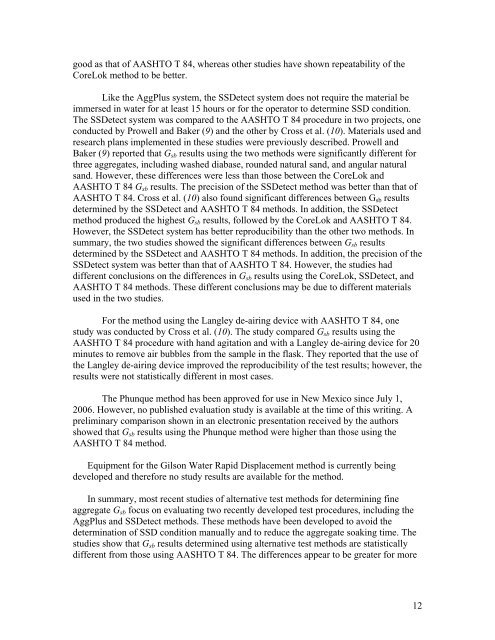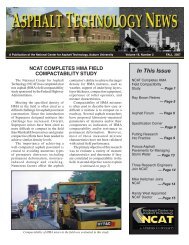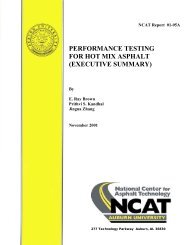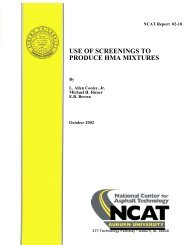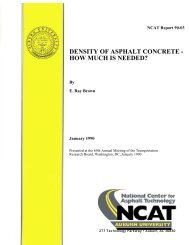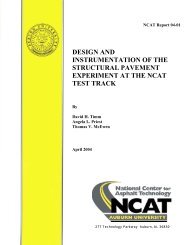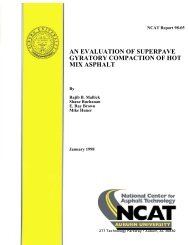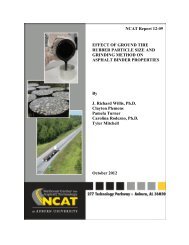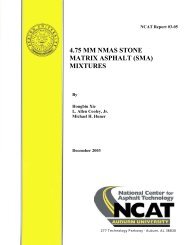A Review of Aggregate and Asphalt Mixture Specific Gravity ...
A Review of Aggregate and Asphalt Mixture Specific Gravity ...
A Review of Aggregate and Asphalt Mixture Specific Gravity ...
Create successful ePaper yourself
Turn your PDF publications into a flip-book with our unique Google optimized e-Paper software.
good as that <strong>of</strong> AASHTO T 84, whereas other studies have shown repeatability <strong>of</strong> theCoreLok method to be better.Like the AggPlus system, the SSDetect system does not require the material beimmersed in water for at least 15 hours or for the operator to determine SSD condition.The SSDetect system was compared to the AASHTO T 84 procedure in two projects, oneconducted by Prowell <strong>and</strong> Baker (9) <strong>and</strong> the other by Cross et al. (10). Materials used <strong>and</strong>research plans implemented in these studies were previously described. Prowell <strong>and</strong>Baker (9) reported that G sb results using the two methods were significantly different forthree aggregates, including washed diabase, rounded natural s<strong>and</strong>, <strong>and</strong> angular naturals<strong>and</strong>. However, these differences were less than those between the CoreLok <strong>and</strong>AASHTO T 84 G sb results. The precision <strong>of</strong> the SSDetect method was better than that <strong>of</strong>AASHTO T 84. Cross et al. (10) also found significant differences between G sb resultsdetermined by the SSDetect <strong>and</strong> AASHTO T 84 methods. In addition, the SSDetectmethod produced the highest G sb results, followed by the CoreLok <strong>and</strong> AASHTO T 84.However, the SSDetect system has better reproducibility than the other two methods. Insummary, the two studies showed the significant differences between G sb resultsdetermined by the SSDetect <strong>and</strong> AASHTO T 84 methods. In addition, the precision <strong>of</strong> theSSDetect system was better than that <strong>of</strong> AASHTO T 84. However, the studies haddifferent conclusions on the differences in G sb results using the CoreLok, SSDetect, <strong>and</strong>AASHTO T 84 methods. These different conclusions may be due to different materialsused in the two studies.For the method using the Langley de-airing device with AASHTO T 84, onestudy was conducted by Cross et al. (10). The study compared G sb results using theAASHTO T 84 procedure with h<strong>and</strong> agitation <strong>and</strong> with a Langley de-airing device for 20minutes to remove air bubbles from the sample in the flask. They reported that the use <strong>of</strong>the Langley de-airing device improved the reproducibility <strong>of</strong> the test results; however, theresults were not statistically different in most cases.The Phunque method has been approved for use in New Mexico since July 1,2006. However, no published evaluation study is available at the time <strong>of</strong> this writing. Apreliminary comparison shown in an electronic presentation received by the authorsshowed that G sb results using the Phunque method were higher than those using theAASHTO T 84 method.Equipment for the Gilson Water Rapid Displacement method is currently beingdeveloped <strong>and</strong> therefore no study results are available for the method.In summary, most recent studies <strong>of</strong> alternative test methods for determining fineaggregate G sb focus on evaluating two recently developed test procedures, including theAggPlus <strong>and</strong> SSDetect methods. These methods have been developed to avoid thedetermination <strong>of</strong> SSD condition manually <strong>and</strong> to reduce the aggregate soaking time. Thestudies show that G sb results determined using alternative test methods are statisticallydifferent from those using AASHTO T 84. The differences appear to be greater for more12


